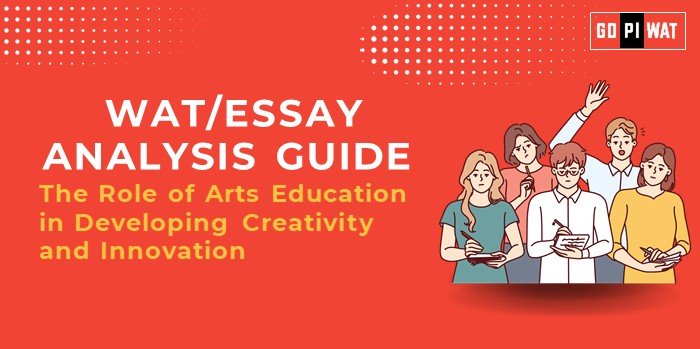📋 WAT Guide: The Role of Arts Education in Developing Creativity and Innovation
🌟 Understanding the Topic’s Importance
Arts education is essential for developing skills like creativity, emotional intelligence, and problem-solving, which are increasingly valued in both business and society. These skills are directly linked to leadership, innovation, and holistic decision-making.
📝 Effective Planning and Writing
Planning: 5 minutes | Writing: 20 minutes | Review: 5 minutes
Preparation Tips: Research the cognitive, emotional, and societal benefits of arts education. Include examples from global leaders in arts integration.
💡 Introduction Techniques
1. Contrast Approach: “While STEM education dominates, the rising importance of creativity highlights the need to integrate arts for a balanced future.”
2. Solution-Based: “Incorporating arts education into curricula addresses gaps in creativity and innovation essential for tomorrow’s leaders.”
📚 Structuring the Essay Body
- 🏆 Achievements: Highlight cognitive and emotional benefits. Showcase examples linking arts education to workforce innovation and creative industries.
- ⚖️ Challenges: Discuss budgetary constraints and global disparities, citing Finland’s success and challenges in underfunded regions.
- 🔮 Future Outlook: Advocate for STEAM education models, increased funding, and policy shifts to integrate arts into education.
🔗 Concluding Effectively
Balanced Perspective: “Arts education is as crucial as STEM for cultivating innovation and emotional intelligence, shaping well-rounded leaders of tomorrow.”
Global Comparison: “From Finland to South Korea, nations prioritizing arts education reap long-term benefits in innovation and leadership.”
✍️ Sample Short Essays
1. Balanced Perspective:
“Arts education fosters creativity and problem-solving, addressing workforce needs. While STEM dominates budgets, integrating arts ensures a holistic skill set, vital for the future.”
2. Solution-Oriented:
“Expanding arts education through public-private partnerships can bridge funding gaps and promote creativity, driving innovation in all fields.”
3. Global Comparison:
“Finland’s integration of arts into education reflects its leadership in creativity. India can emulate this success to enhance its global competitiveness.”


